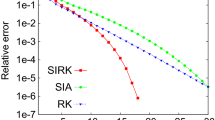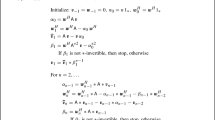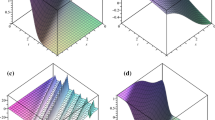Abstract
Linear and nonlinear evolution equations have been formulated to address problems in various fields of science and technology. Recently, methods using an exponential integrator for solving evolution equations, where matrix functions must be computed repeatedly, have been investigated and refined. In this paper, we propose a new method for computing these matrix functions which is called an inexact rational Krylov method. This is a more efficient version of the rational Krylov method with appropriate shifts, which was proposed by Hashimoto and Nodera (ANZIAM J 58:C149–C161, 2016). The advantage of the inexact rational Krylov method is that it computes linear equations that appear in the rational Krylov method efficiently while guaranteeing the accuracy of the final solution.






Similar content being viewed by others
Change history
06 September 2021
A Correction to this paper has been published: https://doi.org/10.1007/s10543-021-00894-9
References
Beckermann, B., Reichel, L.: Error estimates and evaluation of matrix functions via the Faber transform. SIAM J. Numer. Anal. 47(5), 3849–3883 (2009)
Benzi, M., Boito, P., Razouk, N.: Decay properties of spectral projectors with applications to electronic structure. SIAM Rev. 55(1), 3–64 (2013)
Berljafa, M., Güttel, S.: Parallelization of the rational Arnoldi algorithm. SIAM J. Sci. Comput. 39(5), S197–S221 (2017)
Börner, R., Ernst, O.G., Güttel, S.: Three-dimensional transient electromagnetic modelling using rational Krylov methods. Geophys. J. Int. 202(3), 2025–2043 (2015)
Botchev, M.A.: Krylov subspace exponential time domain solution of Maxwell’s equations in photonic crystal modeling. J. Comput. Appl. Math. 293, 20–34 (2016)
Bouras, A., Frayssé, V., Giraud, L.: A relaxation strategy for inner-outer linear solvers in domain decomposition methods. Technical report TR/PA/00/17 (2000)
Crouzeix, M., Palencia, C.: The numerical range is a \((1+\sqrt{2})\)-spectral set. SIAM J. Matrix Anal. Appl. 38(2), 649–655 (2017)
Dinh, K., Sidje, R.: An application of the Krylov-FSP-SSA method to parameter fitting with maximum likelihood. Phys. Biol. 14(6), 065001 (2017)
Druskin, V., Lieberman, C., Zaslavsky, M.: On adaptive choice of shifts in rational Krylov subspace reduction of evolutionary problems. SIAM J. Sci. Comput. 32(5), 2485–2496 (2010)
Elsworth, S., Güttel, S.: The block rational Arnoldi method. SIAM J. Matrix Anal. Appl. 41(2), 365–388 (2020)
Gallopoulos, E., Saad, Y.: Efficient solution of parabolic equations by Krylov approximation methods. SIAM J. Sci. Stat. Comput. 13(5), 1236–1264 (1992)
Göckler, T.: Rational Krylov Subspace Methods for ’\(\phi \)’-functions in Exponential Integrators. Karlsruher Instituts für Technologie, Karlsruhe (2014)
Giraud, L., Langou, J., Rozložník, M., van den Eshof, J.: Rounding error analysis of the classical Gram-Schmidt orthogonalization process. Numer. Math. 101(1), 87–100 (2005)
Golub, G.H., Zhang, Z., Zha, H.: Large sparse symmetric eigenvalue problems with homogeneous linear constraints: the Lanczos process with inner-outer iterations. Linear Algebra Its Appl. 309(1), 289–306 (2000)
Grimm, V.: Resolvent Krylov subspace approximation to operator functions. BIT Numer. Math. 52, 639–659 (2012)
Güttel, S.: Rational Krylov Methods for Operator Functions. Technischen Universität Bergakademie Freiberg, Freiberg (2010)
Güttel, S.: Rational Krylov approximation of matrix functions: numerical methods and optimal pole selection. GAMM-Mitteilungen 36(1), 8–31 (2013)
Hashimoto, Y., Nodera, T.: Inexact shift-invert Arnoldi method for evolution equations. ANZIAM J. 58, E1–E27 (2016)
Hashimoto, Y., Nodera, T.: Shift-invert rational Krylov method for evolution equations. ANZIAM J. 58, C149–C161 (2016)
Higham, N.J.: The scaling and squaring method for the matrix exponential revisited. SIAM J. Matrix Anal. Appl. 26(4), 1179–1193 (2005)
Hochbruck, M., Lubich, C.: On Krylov subspace approximations to the matrix exponential operator. SIAM J. Numer. Anal. 34(5), 1911–1925 (1998)
Hochbruck, M., Lubich, C., Selhofer, H.: Exponential integrators for large systems of differential equations. SIAM J. Sci. Comput. 19(5), 1552–1574 (1997)
Hochbruck, M., Ostermann, A.: Exponential Runge–Kutta methods for parabolic problems. Appl. Numer. Math. 53(2–4), 323–339 (2005)
Hochbruck, M., Ostermann, A.: Exponential integrators. Acta Numer. 19, 209–286 (2010)
Horn, R.A., Johnson, C.R.: Topics in Matrix Analysis. Cambridge University Press, New York (1991)
Lopez, L., Simoncini, V.: Analysis of projection methods for rational function approximation to the matrix exponential. SIAM J. Numer. Anal. 44(2), 613–635 (2006)
Moler, C., Van Loan, C.: Nineteen dubious ways to compute the exponential of a matrix, twenty-five years later. SIAM Rev. 45(1), 3–49 (2003)
Moret, I.: On RD-rational Krylov approximations to the core-functions of exponential integrators. Numer. Linear Algebra Appl. 14(5), 445–457 (2007)
Moret, I., Novati, P.: RD-rational approximations of the matrix exponential. BIT Numer. Math. 44(3), 595–615 (2004)
Moret, I., Novati, P.: On the convergence of Krylov subspace methods for matrix Mittag-Leffler functions. SIAM J. Numer. Anal. 49(5), 2144–2164 (2011)
Moret, I., Popolizio, M.: The restarted shift-and-invert Krylov method for matrix functions. Numer. Linear Algebra Appl. 21(1), 68–80 (2014)
Novati, P.: Using the restricted-denominator rational Arnoldi method for exponential integrators. SIAM J. Matrix Anal. Appl. 32(4), 1537–1558 (2011)
Popolizio, M., Simoncini, V.: Acceleration techniques for approximating the matrix exponential operator. SIAM J. Matrix Anal. Appl. 30(2), 657–683 (2008)
Qiu, C., Güttel, S., Ren, X., Yin, C., Liu, Y., Zhang, B., Egbert, G.: A block rational Krylov method for 3-D time-domain marine controlled-source electromagnetic modelling. Geophys. J. Int. 218(1), 100–113 (2019)
Ruhe, A.: Rational Krylov: a practical algorithm for large sparse nonsymmetric matrix pencils. SIAM J. Sci. Comput. 19(5), 1535–1551 (1998)
Saad, Y., Schultz, M.H.: GMRES: a generalized minimal residual algorithm for solving nonsymmetric linear systems. SIAM J. Sci. Stat. Comput. 7(3), 856–869 (1986)
Saff, E.B., Schönhage, A., Varga, R.S.: Geometric convergence to \(e^{-z}\) by rational functions with real poles. Numer. Math. 25(3), 307–322 (1975)
Sidje, R.B., Winkles, N.: Evaluation of the performance of inexact GMRES. J. Comput. Appl. Math. 235(8), 1956–1975 (2011)
Simoncini, V., Szyld, D.B.: Theory of inexact Krylov subspace methods and applications to scientific computing. SIAM J. Sci. Comput. 25(2), 454–477 (2003)
Skoogh, D.: A parallel rational Krylov algorithm for eigenvalue computations. In: Applied Parallel Computing Large Scale Scientific and Industrial Problems, pp. 521–526 (1998)
Svoboda, Z.: The convective-diffusion equation and its use in building physics. Int. J. Archit. Sci. 1(2), 68–79 (2000)
Van den Eshof, J., Sleijpen, G.L.G.: Inexact Krylov subspace methods for linear systems. SIAM J. Matrix Anal. Appl. 26(1), 125–153 (2004)
Van den Eshof, J., Hochbruck, M.: Preconditioning Lanczos approximations to the matrix exponential. SIAM J. Sci. Comput. 27(4), 1438–1457 (2006)
Van der Vorst, H.A.: Bi-CGSTAB: a fast and smoothly converging variant of Bi-CG for the solution of nonsymmetric linear systems. SIAM J. Sci. Stat. Comput. 13(2), 631–644 (1992)
Wu, G., Feng, T., Wei, Y.: An inexact shift-and-invert Arnoldi algorithm for Toeplitz matrix exponential. Numer. Linear Algebra Appl. 22(4), 777–792 (2015)
Wu, G., Feng, T., Zhang, L., Yang, M.: Inexact implementation using Krylov subspace methods for large scale exponential discriminant analysis with applications to high dimensionality reduction problems. Pattern Recognit. 66, 328–341 (2017)
Zhang, D.S., Wei, G.W., Kouri, D.J., Hoffman, D.K.: Burgers’ equation with high Reynolds number. Phys. Fluids 9(6), 1853–1855 (1997)
Zhu, H., Shu, H., Ding, M.: Numerical solutions of two-dimensional Burgers’ equations by discrete Adomian decomposition method. Comput. Math. Appl. 60(3), 840–848 (2010)
Acknowledgements
We would like to thank the anonymous referee and associate editor Michiel Hochstenbach, whose suggestions greatly improved the paper.
Author information
Authors and Affiliations
Corresponding author
Additional information
Communicated by Michiel E. Hochstenbach.
Publisher's Note
Springer Nature remains neutral with regard to jurisdictional claims in published maps and institutional affiliations.
Appendices
A Proof of Proposition 3.1
We use the Householder reflectors for transforming the matrix \(\tilde{K}_m\) into an upper Hessenberg matrix. Let \(u_j:=(\tilde{k}_{j+1:m,j}-\eta _j e_1)/\Vert \tilde{k}_{j+1:m,j}-\eta _j e_1\Vert \) and let \(\tilde{Q}_{j+1}:=-2u_ju_j^*\). Then, \(I_{m-j}+\tilde{Q}_{j+1}\) is a unitary matrix and satisfies \((I_{m-j}+\tilde{Q}_{j+1})k_{j+1:m,j}=\eta _je_1\). Thus, the matrix \(Q_m\) which is defined as \(Q_m:=(I_m+\hat{Q}_{m-1})\cdots (I_m+\hat{Q}_2)\) is a unitary matrix, and there exists an upper Hessenberg matrix \(H_m\) such that \(Q_m\tilde{K}_mQ_m^*=H_m\). Here, \(\hat{Q}_{j+1}:={\text {diag}}\{O_j,\ \tilde{Q}_{j+1}\}\) and \(O_j\) is the \(j\times j\) zero matrix.
Our first goal is to evaluate the magnitude of each element of the matrix \(\tilde{Q}_{j+1}\). By the assumption (3.11), the inequality \(\Vert \tilde{k}_{j+1:m,j}-\eta _j e_1\Vert \ge \eta \) holds. In addition, since the vector \(\tilde{k}_{j+1:m,j}\) satisfies the condition (3.10), we have
The first element of the vector \(\tilde{k}_{j+1:m,j}-\eta _je_1\) is equal to \(\tilde{k}_{j+1,j}-\eta _j\), and since the identity \(\vert \eta _j\vert =\Vert \tilde{k}_{j+1:m,j}\Vert \) holds, we obtain \(\vert \tilde{k}_{j+1,j}-\eta _j\vert \le 2\vert \eta _j\vert \). All the elements except for the first element of the vector \(\tilde{k}_{j+1:m,j}-\eta _je_1\) are the same as the element \(\tilde{k}_{j+1:m,j}\). For these reasons, on the basis of the assumption (3.10), \(|u_{i,j}|<\tilde{\alpha }\hat{\lambda }^i\) is satisfied for
where \(u_{i,j}\) is the ith element of the vector \(u_j\in \mathbb {C}^{m-j}\). Thus, we have
Next, we evaluate the magnitude of each element of the matrix \(Q_m\). Let \(\check{\alpha }:=2\tilde{\alpha }^2\). For \(l\ge 2\) and \(l<k_1<k_2<\cdots <k_r\), we have
where \(\alpha ''(l,r):=\hat{\lambda }^{-2(l-r-1)}/(1-\hat{\lambda }^2)^r\). The inequality (A.1) is proved by the induction on r. For \(r=1\), we have
For \(r\ge 2\), if the inequality (A.1) is satisfied with \(r-1\), then we obtain
and the inequality (A.1) is also satisfied with r. This is the proof of the inequality (A.1). In the inequality (A.1), if \(\hat{\lambda }\le 1/\sqrt{2}\) is satisfied, then the inequality \(\alpha ''(l,r+1)\le \alpha ''(l,r)\) holds for any l. This results in \(\alpha ''(l,r)\le \alpha ''(l,1)\) for any r and l. The matrix \(Q_m\) can be represented as
As a result, for \(2\le \min {\{i,j\}}\le m-1\), the Eq. (A.2) and inequality (A.1) derive
Therefore, for \(2\le \min {\{i,j\}}\le m-1\) and \(i\le j\), under the assumptions of (3.11) and (3.12), we have
where the sum \(\sum _{k=3}^i\) becomes 0 for \(i=2\), and we use the assumption (3.12) to derive the second inequality. In a similar manner, it can be deduced that \(|(Q_m-I_m)_{i,j}|\le \alpha '\hat{\lambda }^{i-j}\) for \(i>j\). In the case of \(\min {\{i,j\}}=m\), the identity \(i=j=m\) holds and we obtain
For \(\min {\{i,j\}}=1\), by the definition of the matrix \(Q_m\), we have
Since the matrix \(I_m\) is a diagonal matrix, redefining the constant \(\alpha '\) as the sum of 1 and the previous \(\alpha '\) completes the proof.
B Proof of Proposition 3.2
First, we apply Lemma 3.1 and Proposition 3.1 to the matrix \(\phi _k\left( D_m-H_m^{-1}T_m\right) H_m^{-1}\). Since the matrix \(H_m\) is an upper Hessenberg matrix satisfying the condition (3.13), by setting \(f(z)=z^{-1}\) and applying Lemma 3.1, there exist constants \(\hat{\alpha }>0\) and \(0<\hat{\lambda }<1\) which satisfy the following inequality:
Since the matrix \(D_m\) is a diagonal matrix and the matrix \(T_m\) is defined as the Eq. (2.5), redefining the constant \(\hat{\alpha }\) as the sum of \(\Vert D_m\Vert =N-h\) and the previous \(\hat{\alpha }\) leads to
where the constants \(\hat{\alpha }\) and \(\hat{\lambda }\) do not depend on m. Let
By Proposition 3.1, there exists a unitary matrix \(Q_m\) and an upper Hessenberg matrix \(\tilde{H}_m\) such that \(D_m-H_m^{-1}T_m=Q_m^*\tilde{H}_mQ_m\) and \(Q_m\in \mathscr {G}^{{\text {exp}}}(\alpha ',\hat{\lambda })\), where \(\alpha '>0\) is a constant which does not depend on m. Thus, it is deduced that there exists a matrix \(\hat{H}_m\in \mathscr {G}^{{\text {exp}}}(\hat{\alpha },\hat{\lambda })\) such that
The second equality holds, since by the inequality (B.1), there exists a matrix \(\hat{H}_m\!\in \mathscr {G}^{{\text {exp}}}(\hat{\alpha },\hat{\lambda })\) which satisfies \(H_m^{-1}e_1=\hat{H}_me_1\).
Our task is now to derive an upper bound of the magnitude of each element of the matrix \(Q_m^*\phi _k(\tilde{H}_m)Q_m\hat{H}_m\), which is composed of the products of the matrices that have the decay properties. According to Benzi and Boito [2, Theorem 9.2], there exist constants \(\alpha ''>0\) and \(\lambda ''\) which do not depend on m and satisfy \(Q_m\hat{H}_m\in \mathscr {G}^{{\text {exp}}}(\alpha '',\lambda '')\). In addition, because the function \(\phi _k\) is an entire function, by setting \(f=\phi _k\) in Proposition 3.1, there exist constants \(\check{\alpha }>0\) and \(0<\check{\lambda }<1\) satisfying \(\vert (\phi _k(\tilde{H}_m))_{i,j}\vert \le \check{\alpha }\check{\lambda }^{i-j}\) for \(i\ge j\). Let \(\varSigma :=\bigcup _{m=1}^n W(D_m-H_m^{-1}T_m)\). Then, the set \(\varSigma \) is closed and bounded, and the matrix \(\tilde{H}_m\) satisfies
Therefore, \(|e^z|\le C'\) for a constant \(C'>0\) is satisfied for \(z\in W(\tilde{H}_m)\), and we have
Using the result by Crouzeix [7], the condition (B.2), and the inequality (B.3), there exists a constant \(2\le C\le 1+\sqrt{2}\) such that
Redefining the constant \(\check{\alpha }\) as the sum of the constant \(CC'/(k!)\) and the previous \(\check{\alpha }\) results in
By the upper bounds (B.4) and (B.5), we obtain
where \(\bar{\alpha }:=\check{\alpha }\alpha ''/(1-\lambda '')\) and \(\bar{\lambda }:=\max \{\check{\lambda },\lambda ''\}<1\). As a result, using the fact \(Q_m\in \mathscr {G}^{{\text {exp}}}(\alpha ',\hat{\lambda })\) and the upper bound (B.6), we have
where \(\alpha :=\alpha '\bar{\alpha }(1+2\lambda ^2/(1- \lambda ^2)^2)\) and \(\lambda :=\max \{\hat{\lambda },\bar{\lambda }\}<1\). This completes the proof of Proposition 3.2.
Rights and permissions
About this article
Cite this article
Hashimoto, Y., Nodera, T. Inexact rational Krylov method for evolution equations. Bit Numer Math 61, 473–502 (2021). https://doi.org/10.1007/s10543-020-00829-w
Received:
Accepted:
Published:
Issue Date:
DOI: https://doi.org/10.1007/s10543-020-00829-w




